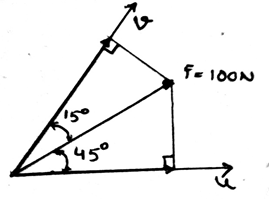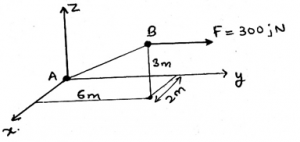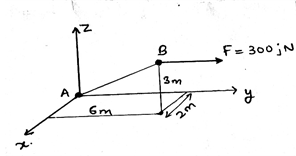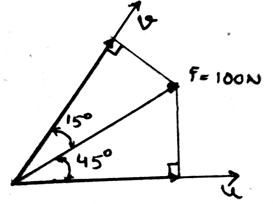This set of Engineering Mechanics Multiple Choice Questions & Answers (MCQs) focuses on “Dot Product and Cross Product – 1”.
1. Determine the magnitude of the projection of the vector force F = 100N, onto u axis, from the figure given below.

a) 96.6N
b) 60N
c) 100N
d) 70.7N
View Answer
Explanation: The component of the force in u axis, it is equal to 100cos(45˚). We need to consider the triangle and then accordingly apply the trigonometry. This is one of the ways of resolving the components.
2. For two vectors A and B, what is A.B (if they have angle α between them)?
a) |A||B| cosα
b) |A||B|
c) √(|A||B|) cosα
d) |A||B| sinα
View Answer
Explanation: The dot product of the two vectors is always the product of the magnitudes of the two forces and the cosine of the angle between them. We need to consider the triangle and then accordingly apply the trigonometry. This is one of the ways of resolving the components.
3. Which statement is right?
a) Communitive law: A.B =B.A
b) Multiplicative law: a(A.B) = Ax(aB)
c) Multiplicative law: A.(B+D) = (A.B) + (A.D)
d) Communitive law: a(A.B) = A.(aB)
View Answer
Explanation: For three vectors A, B and D the various laws are. Communitive law: A.B =B.A. While distributive law is A.(B+D) = (A.B) + (A.D). And multiplication law is a(A.B) = A.(aB).
4. What is Distributive law?
a) A.B =B.A
b) a(A.B) = A.(aB)
c) A.(B+D) = (A.B) + (A.D)
d) a(A.B) = AxB
View Answer
Explanation: For three vectors A, B and D the various laws are. Communitive law: A.B =B.A. While distributive law is A.(B+D) = (A.B) + (A.D). And multiplication law is a(A.B) = A.(aB).
5. What is multiplication law?
a) A.B =B.A
b) a(A.B) = A.(aB)
c) A.(B+D) = (A.B) + (A.D)
d) a(A.B) = AxB
View Answer
Explanation: For three vectors A, B and D the various laws are. Communitive law: A.B =B.A. While distributive law is A.(B+D) = (A.B) + (A.D). And multiplication law is a(A.B) = A.(aB).
6. Which is true for two vector A = A1i + A2j + A3k and B = B1i + B2j + B3k?
a) A.B = A1B1 + A2B2 + A3B3
b) AxB = A1B1 + A2B2 + A3B3
c) A.B = A1B2 + A2B3 + A3B1
d) AxB = A1B2 + A2B3 + A3B1
View Answer
Explanation: The multiplication of x, y and z components with their respective same component give a scalar, equal to 1, i.e. i.i = 1 and j.j = 1, while jxj =0. This is the basic principle of the vector algebra which needs to apply wherever needed.
7. Determine the magnitude of the force F = 300j parallel to the direction of AB?
a) 155N
b) 257.1N
c) 200N
d) 175N
View Answer
Explanation: Force component in the direction parallel to the AB is given by unit vector 0.286i + 0.857j + 0.429k. Now (300j).(0.286i + 0.857j + 0.429k) = 257.1N. Just try to resolve the force into it’s particular components.
8. What is k.i?
a) 0
b) 1
c) -1
d) ∞
View Answer
Explanation: As the dot product of only the same Cartesian component is unity, i.e. i.i = 1 and j.j =1, rest all remaining dot product will give 0(i.j = 0 and j.k = 0). Cross product of the same plane vectors always gives zero. And dot product of the same plane vector gives a scalar quantity.
9. What is {(i.i) + (-i.j) + (-k.k) + (k.i)}.(Ai +Bj + Cz)?
a) 1
b) 0
c) A + B + C
d) -1
View Answer
Explanation: {(i.i) + (-i.j) + (-k.k) + (k.i)} = 0. As (1 + 0 + 0 – 1). Cross product of the same plane vectors always give zero. And dot product of the same plane vector gives a scalar quantity.
10. α = cos-1(A.B/AB). What is the range of α?
a) 0˚<α<90˚
b) 0˚<α<180˚
c) 90˚<α<180C
d) 0˚<α<45˚
View Answer
Explanation: Cosine inverse function is defined only between 0˚ to 180˚. It cannot be defined under any of the given range, because this is the principle range of the inverse cosine function.
11. What is the value of {(AxB).(C.D)x(AxB).(C.D)}? For the four vectors A, B, C and D, with A, B, C and D all lying in the same plane?
a) i + j + k
b) √3(i + j + k)
c) 0
d) -1(i + j + k)
View Answer
Explanation: Here we are trying to do the cross product of the two vectors in the same plane. Which will give us zero. While dot product of the same plane vector will give a scalar quantity, not zero.
12. What is (AxB).(BxA); or A = A1i + A2j + A3k and B = B1i + B2j + B3k?
a) 0
b) A1B1A2B2i + A2B2A3B3j + A3B3A1B1k
c) A1B1A1B2i + A2B2A3B2j + A3B3A1B3k
d) A1B1A2B1i + A2B2A2B3j + A3B3A2B1k
View Answer
Explanation: Here we are trying to do the cross product of the two vectors in the same plane. Which will give us zero. While dot product of the same plane vector will give a scalar quantity, not zero.
13. What is the value of θ in the figure given below?
a) 69˚
b) 60˚
c) 55˚
d) 90˚
View Answer
Explanation: Fab= -(3/5)j + (4/5)k ; F= (4/5)i – (3/5)j ; θ = cos-1(Fab.F) = 69˚. This is the application of the triangle over the figure. Try to resolve the components of the given force. It will be easy.
14. Refer to the diagram given below, determine the magnitude of the force F = 300j perpendicular to the direction of AB.
a) 155N
b) 257.1N
c) 200N
d) 175N
View Answer
Explanation: Force’s component in the direction perpendicular to AB is -73.5i + 80j – 110k N. This is the application of the triangle over the figure. Try to resolve the components of the given force. It will be easy.
15. Determine the magnitude of the projection of the vector force F = 100N, onto the v axis, from the figure given below.
a) 96.6N
b) 60N
c) 100N
d) 70.7N
View Answer
Explanation: The component of the force in the v axis, it is equal to 100cos(15˚). This is the application of the triangle over the figure. Try to resolve the components of the given force. It will be easy.
Sanfoundry Global Education & Learning Series – Engineering Mechanics.
To practice all areas of Engineering Mechanics, here is complete set of 1000+ Multiple Choice Questions and Answers.
If you find a mistake in question / option / answer, kindly take a screenshot and email to [email protected]




